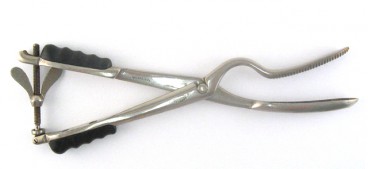Cranioclast

| ACCESSION NUMBER: | 007023010 |
| Object Name: | Braun’s cranioclast |
| Manufacturer: | S. Mawson & Thompson |
| Date Made: | 1890-1920 |
| MeSH Code: Medical Subject Headings | Obstetrical Forceps Extraction, Obstetrical — instrumentation Obstetrics — instrumentation Fetal Death |
ARTEFACT DESCRIPTION
Prior to the 1900s, complicated births, particularly where there was a disproportion between the size of the woman’s pelvis and the foetus’ head, often meant the death of the baby and the mother. Instruments for removing a dead or ailing foetus from within the mother were used to attempt to save the mother’s life.
The cranioclast, first invented by Dr. James Simpson in the mid-19th century and later redesigned by others, was used for fetal destruction and removal. Fundamentally a strong pair of forceps, the cranioclast was used to crush the skull, decreasing its diameter. In some cases, this would allow normal uterine contractions to expel the foetus; in others, the physicians would use an obstetrical hook to pull the body out of the mother.
Doctors disagreed as to the pelvic diameter that would necessitate this drastic intervention, but generally found that 3 to 3.5 inches was the smallest size through which a living infant could pass. Equally of debate was the pelvic size through which the dead fetus could be extracted. When vaginal extraction was deemed unadvisable, Caesarian section would be performed. As caesarean section became safer and more common with the advent of anaesthetics and antiseptic techniques, the use of cranioclasts and obstetrical hooks diminished.
Related: Inconceivable








Leave a Reply